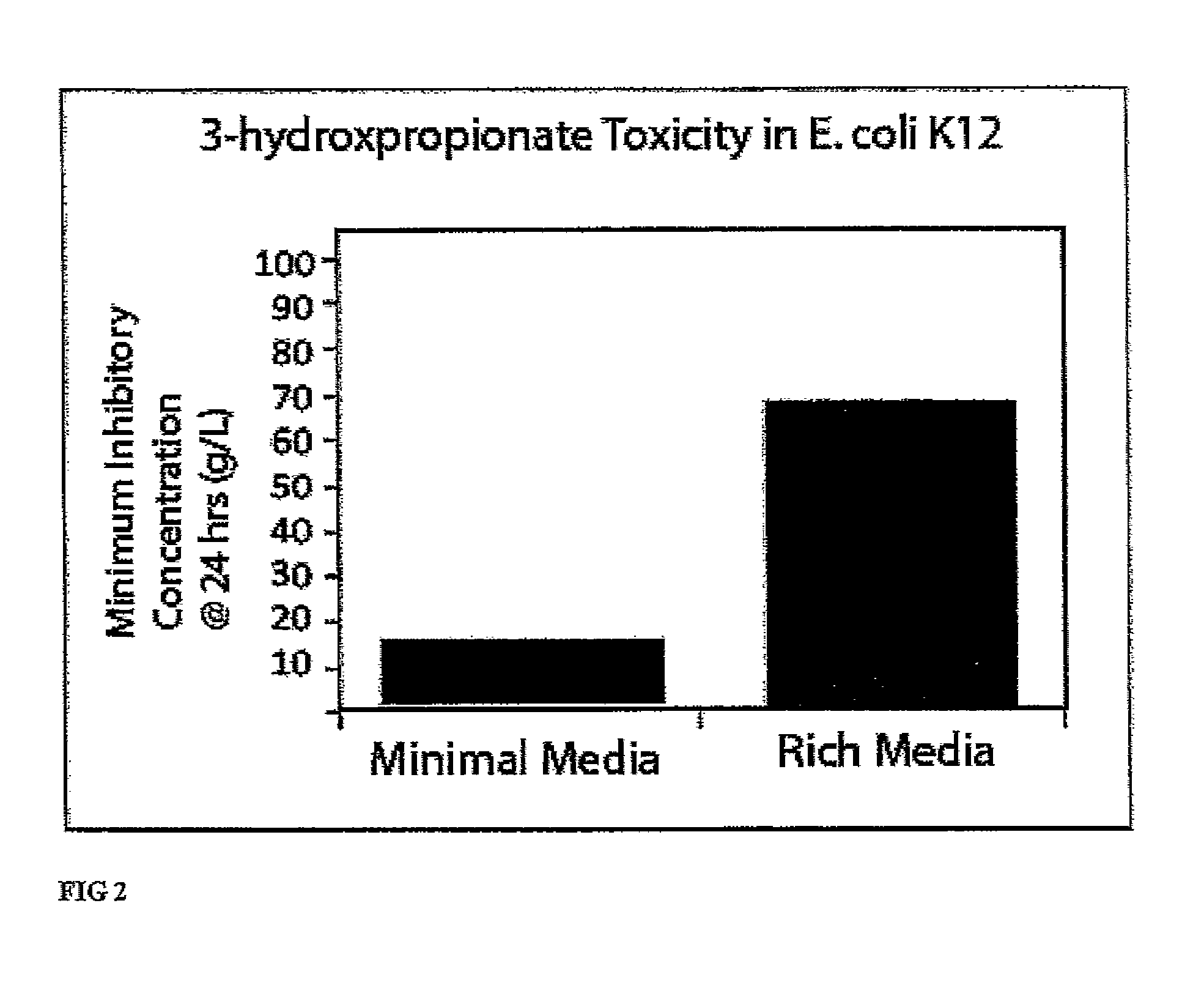Compositions and methods for 3-hydroxypropionate bio-production from biomass
a technology of biomass and 3hydroxypropionate, which is applied in the direction of carbon-carbon lyases, polypeptides with his-tags, lyases, etc., can solve the problems of poor product titer, low product titer, and poor product quality,
- Summary
- Abstract
- Description
- Claims
- Application Information
AI Technical Summary
Problems solved by technology
Method used
Image
Examples
example 1
Development of a Plasmid Comprising kgd
[0081]The nucleic acid sequence for the alpha-ketoglutarate decarboxylase (kgd) from M. tuberculosis was codon optimized for E. coli according to a service from DNA 2.0 (Menlo Park, Calif. USA), a commercial DNA gene synthesis provider. The nucleic acid sequence was synthesized with an eight amino acid N-terminal tag to enable affinity based protein purification. This nucleic acid sequence incorporated an NcoI restriction site overlapping the gene start codon and was followed by a HindIII restriction site. In addition a Shine Delgarno sequence (i.e., a ribosomal binding site) was placed in front of the start codon preceded by an Ecor1 restriction site. This codon optimized kgd nucleic acid sequence construct (SEQ ID NO:001), which is designed to encode for the native kgd protein (SEQ ID NO:002) was synthesized by DNA 2.0 and then provided in a pJ206 vector backbone (SEQ ID NO:003).
[0082]A circular plasmid based cloning vector termed pKK223-kgd ...
example 2
Development of a Plasmid Comprising mcr (Partial Prophetic)
[0087]The nucleic acid sequence for the malonyl-coA reductase gene (mcr) from Chloroflexus auranticus was codon optimized for E. coli according to a service from DNA 2.0 (Menlo Park, Calif. USA), a commercial DNA gene synthesis provider. Attached and extending beyond the ends of this codon optimized mcr nucleic acid sequence (SEQ ID NO:011) were an EcoRI restriction site before the start codon and a HindIII restriction site. In addition a Shine Delgarno sequence (i.e., a ribosomal binding site) was placed in front of the start codon preceded by an EcoRI restriction site. This gene construct was synthesized by DNA 2.0 and provided in a pJ206 vector backbone.
[0088]A circular plasmid based cloning vector termed pKK223-mcr for expression of the malonyl-CoA reductase in E. coli was constructed as follows. The mcr gene in the pJ206 vector was amplified via a polymerase chain reaction with the forward primer being TCGTACCAACCATGGCC...
example 3
Development of a Plasmid Comprising a Beta Alanine-Pyruvate Aminotransferase Gene. (Prophetic)
[0093]Introduction of a gene, such as the beta alanine pyruvate aminotransferase gene, into bacterial cells requires the addition of transcriptional (promoters) and translational (ribosome binding site) elements for controlled expression and production of proteins encoded by the gene. A nucleic acid sequence for a gene, whether obtained by gene synthesis or by amplification by polymerase chain reaction from genomic sources, can be ligated to nucleic acid sequences defining these transcriptional and translational elements. The present example discloses the addition of an E. coli minimal promoter and ribosome binding site properly oriented in the nucleic acid sequence before a gene of interest.
[0094]The beta alanine pyruvate aminotransferase gene from Pseudomonas aeruginosa PAO1 (locus_tag=“PA0132”) is amplified by polymerase chain reaction from a genomic DNA template with the forward primer ...
PUM
| Property | Measurement | Unit |
|---|---|---|
| concentration | aaaaa | aaaaa |
| pH | aaaaa | aaaaa |
| doubling time | aaaaa | aaaaa |
Abstract
Description
Claims
Application Information
 Login to View More
Login to View More - R&D
- Intellectual Property
- Life Sciences
- Materials
- Tech Scout
- Unparalleled Data Quality
- Higher Quality Content
- 60% Fewer Hallucinations
Browse by: Latest US Patents, China's latest patents, Technical Efficacy Thesaurus, Application Domain, Technology Topic, Popular Technical Reports.
© 2025 PatSnap. All rights reserved.Legal|Privacy policy|Modern Slavery Act Transparency Statement|Sitemap|About US| Contact US: help@patsnap.com



